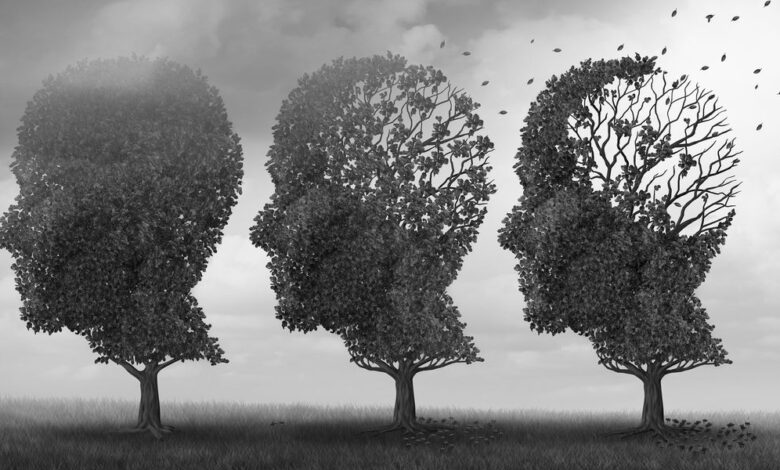8 Types of Dementia and How to Identify Common Symptoms

[ad_1]
For most people, Alzheimer’s disease is the first condition they think of when they hear the word dementia—and for understandable reasons. The degenerative brain disease is the most common type of dementia, an umbrella term for loss of memory, language, and other thinking abilities that become severe enough to interfere with a person’s daily life. However, Alzheimer’s is far from the only one.
There are literally hundreds of different conditions that can cause memory loss, confusion, personality changes, and problems with walking, speaking, and comprehension, says Douglas Scharre, M.D., director of the division of cognitive neurology at Ohio State Wexner Medical Center. “Dementia means that the brain isn’t working well—there are treatable types, reversible types, and types we have limited options for,” he says.
Finding out exactly which type of dementia you or your loved one has may be scary, but it’s important to identify the condition as early as possible, says Rebecca Edelmayer, Ph.D., senior director of scientific engagement for the Alzheimer’s Association. Early detection and an accurate diagnosis can help a person make lifestyle changes to possibly slow the rate of decline, make critical decisions about their healthcare, and even open the opportunity of participating in clinical trials for new treatments.
To assess which type of dementia (or mix of dementias) a patient has, a doctor will typically collect information from both the patient and their family about their collection of symptoms, when they started appearing, and how they’re progressing, says Elise Caccappolo, Ph.D., associate professor of neuropsychology at Columbia University Irving Medical Center. They may also send the patient for blood tests, an MRI, a CT scan, and in some cases, a spinal tap to check for proteins that are consistent with certain types of dementia. A neuropsychological assessment (in which the patient is asked to perform tasks such as drawing specific shapes and remembering details from a story they’re told) also helps narrow down the diagnosis.
In the best-case scenario, the results may show that there is a reversible cause of the dementia symptoms, such as a vitamin deficiency, side effects from medications, sleep apnea, or a thyroid condition—though Dr. Scharre points out that a reversible diagnosis is more likely when the patient is younger than 65. Even with non-reversible, degenerative forms of dementia, there is reason for hope: “We are learning so much about Alzheimer’s and all types of dementia,” says Edelmayer. “There is a lot of amazing research going on with new diagnostic tests, early detection, future treatments—even potential preventative strategies.”
Ahead, experts break down eight different types of dementia and the symptoms they’re associated with.
1. Alzheimer’s disease
What it is: The most common cause of dementia, Alzheimer’s affects an estimated 60 to 80% of all people with dementia. The disease, which is believed to be caused by plaques and tangles that form in the brain, destroying both the brain cells and the connections between them, can start developing years before any symptoms appear. Most people with Alzheimer’s start experiencing symptoms in their 60s or 70s or even later, but in about 5% of cases, symptoms may start appearing at a younger age. One hallmark of Alzheimer’s is a steady progression of symptoms over several years, says Caccappolo.
Symptoms: As Dr. Scharre says, Alzheimer’s is about “memory, memory, memory.” In the early stages of Alzheimer’s, known as mild cognitive impairment, people will experience forgetfulness, they’ll repeat things many times, often in the same conversation, and be unable to retain new information. They may also get confused trying to perform simple tasks, or lost walking or driving in a familiar area.
As the disease progresses, they may become confused about time of day, have difficulty following a conversation, and forget the names of friends and family members. Eventually they will lose the ability to speak, walk, and eat on their own.
For more information: Alzheimer’s Association
2. Vascular dementia
What it is: Vascular dementia is considered the second most common type of dementia, accounting for about 15 to 20% of cases in North America and Europe (the numbers are slightly higher in Asia). Vascular dementia occurs when blood flow to part of the brain is blocked off, depriving the neurons of oxygen and damaging or eventually killing off those cells. This often occurs after a major stroke or a series of small strokes (known as transient ischemic attacks, or TIAs), or it can be due to a brain hemorrhage or the narrowing of blood vessels due to high blood pressure, diabetes, or atherosclerosis (when arteries get clogged with fat, cholesterol, and other substances). People over the age of 65 are most commonly affected, and risk increases with age. It is common to have a mix of Alzheimer’s and vascular dementia, says Edelmayer.
Symptoms: The symptoms vary depending on the severity of the stroke and the part of the brain that has been affected. Early symptoms can include difficulties with language, inability to pay attention, inappropriate emotional outbursts, and poor planning and judgment. Later symptoms can include memory loss, confusion, impaired motor skills, depression, loss of bladder control, and even hallucinations.
A major hallmark of vascular dementia is that instead of the steady progression of Alzheimer’s, symptoms may appear suddenly, in a “stepwise” progression, says Caccappolo, with each TIA, causing an onset of new symptoms that can then stabilize for a time, getting worse after the next vascular event .
For more info: American Stroke Association
3. Lewy body dementia
What it is: Lewy body dementia (LBD) affects about 1.4 million Americans, most over age 50. Many people first heard of the disease when it was discovered that Robin Williams suffered from undiagnosed LBD before his death. In this type of dementia, a protein called alpha-synuclein forms clumps called Lewy bodies, which accumulate in nerve cells in the area of the brain responsible for memory, motor control, and thinking. LBD is related to Parkinson’s disease, in which the alpha-synuclein proteins build up first in the part of the brain that controls movement and may spread over time to the areas responsible for memory and cognition.
Symptoms: Symptoms may depend upon where in the brain the Lewy bodies form first. One of the hallmarks of Lewy body dementia is visual hallucinations and delusions: People may report seeing things that aren’t there. They may also act out their dreams. The disease also impairs memory, the ability to plan activities and process information, attention, and alertness.
As LBD progresses, the patient may also suffer from the physical symptoms of Parkinson’s, including rigid muscles, tremors, and trouble walking. Moods and awareness fluctuate widely, says Caccappolo. “There can be really good days and really bad days,” she says. “Some days the person may seem almost like back to normal, other times they’re really out of it. The changes can be day to day or even change within a day.”
For more information: Lewy Body Dementia Association
4. Frontotemporal dementia
What it is: Frontotemporal dementia (FTD) is less common, affecting 60,000 Americans per year—however, it is the most common type of dementia for people under age 60, according to the Association for Frontotemporal Degeneration. There are several different types of dementia that fall under the category of frontotemporal (FTD), but what they all share in common is that different proteins attack the brain’s frontal and temporal lobes, which are responsible for behavior, language, and motor function.
Symptoms: Because FTD starts in the frontal lobe, which is responsible for mood and behavior, the person often becomes aggressive or apathetic, displays a lack of empathy, may use inappropriate language, and even act out sexually. Because of this, FTD is often mistaken for a psychiatric disorder, says Caccappolo. “The patient’s partner may come in and say they think they’re depressed or bipolar,” she explains. “It can be very hard on the caregiver.”
People with FTD may also have unusual cravings and eating patterns, and experience compulsions like demanding to watch the same movie over and over, adds Dr. Scharre. Depending on the type of FTD, other symptoms may include problems with speaking, writing, and comprehension skills, and muscle weakness and atrophy. Unlike with Alzheimer’s, memory loss is not a major symptom.
For more info: The Association for Frontotemporal Degeneration
5. Normal pressure hydrocephalus
What it is: Normal pressure hydrocephalus (NPH) is one type of dementia that can be successfully treated, says Dr. Scharre. It occurs when excess cerebrospinal fluid (CSF) accumulates in the brain’s ventricles (a network of cavities). As the ventricles enlarge, they can interfere with nearby brain tissue. “Maybe you hit your head or have a little bit of blood in the spinal fluid from trauma or an infection, then it sort of gums up the drain, so it’s not draining as well. So, you’re overproducing fluid and not draining it fast enough,” Dr. Scharre explains.
NPH can be treated with the surgical insertion of a shunt, which drains the excess fluid from the brain into the abdomen. “The doctor will first test it by taking a little fluid out to see if it helps, and if it works, they’ll schedule surgery to put in the shunt,” Caccappolo explains. It’s estimated that 700,000 Americans have NPH, though only 1 in 5 receive a proper diagnosis, since it is often mistaken for Alzheimer’s, Parkinson’s, or “normal aging,” per the Hydrocephalus Association.
Symptoms: NPH is sometimes diagnosed after a head injury, a tumor, meningitis, or other trauma, but in most cases the causes in unknown. It has three main symptoms, which can appear all together or at different stages of the disease: urinary incontinence, difficulty with balance and walking, and cognitive problems including short-term memory loss, mood changes, and difficulty making decisions and performing tasks.
For more information: Hydrocephalus Association
6. Huntington’s disease
What it is: About 40,000 Americans have this progressive, inherited brain disorder, passed down through a mutation on the huntingtin gene, which primarily affects the area of the brain that plays a key role in movement, behavior, and mood. Symptoms usually develop between the ages of 30 and 50, but they can appear earlier or later. “If a parent has Huntington’s, the child has a 50-50 chance of developing it, too,” Caccappolo explains. (Pre-genetic testing can be used in conjunction with IVF for adults with the gene who want to have children without passing on the disease.)
Symptoms: Early symptoms of Huntington’s include difficulties planning, remembering, and staying on task, as well as physical difficulties, like being unable to hold a cup without dropping it. As the disease progresses, symptoms include involuntary movements (known as chorea), slurred speech, and abnormal twisting of the arm, knee, or foot. In the later stages, they may experience significant memory loss similar to what is seen in Alzheimer’s, says Dr. Scharre.
For more information: Huntington’s Disease Society
7. Creutzfeldt-Jakob disease
What it is: An extremely rare brain disorder that strikes only about 350 Americans each year, CJD is a fast-moving, fatal disease caused by an infectious, misfolded prion protein in the brain. The disease can be inherited or—very rarely—it can be acquired by eating meat from infected animals (the “mad cow” crisis in the 1990s in the U.K. was one notable breakout of the disease) or by having a medical procedure in which infected tissue, such as a cornea, is implanted. In most cases, there is no known cause.
Symptoms: The biggest red flag with CJD is how quickly it progresses. “CJD comes on very quickly and has a rapid decline,” says Caccappolo. “Often by the time a patient is diagnosed with it, they’re already in the hospital.” Symptoms can include depression, mood swings, agitation, and confusion, as well as difficulties with memory and judgment. As the disease rapidly affects the brain, the patient can have trouble walking and experience muscle twitches, involuntary movements, blindness, and hallucinations.
For more info: National Institute of Neurological Disorders and Stroke
8. Wernicke-Korsakoff syndrome
What it is: Wernicke-Korsakoff (WK) syndrome is a degenerative brain disease caused by a deficiency of thiamine (vitamin B1). In most cases, the vitamin deficiency is associated with long-term alcoholism, but severe weight loss due to anorexia or other illnesses can also result in extremely low levels. When the disease is in its earliest phase, it’s called Wernike; if it’s left untreated, Wernike can lead to chronic, irreversible Korsakoff syndrome, which unfortunately happens in about 80 to 90% of cases.
Symptoms: People with WK syndrome experience memory loss, vision problems, lack of concentration, and disorientation. They also experience ataxia, the inability to coordinate voluntary movement. As the disease progresses, they experience memory loss and the inability to retain information. They are frequently able to keep up a socially appropriate conversation as if nothing is wrong, though Caccappolo points out one common coping mechanism: “One hallmark of the disease is confabulation—they can’t remember certain things from their past, so they fill in the gaps by making things up.”
For more information: National Organization of Rare Disorders
This content is created and maintained by a third party, and imported onto this page to help users provide their email addresses. You may be able to find more information about this and similar content at piano.io
[ad_2]
Source link






